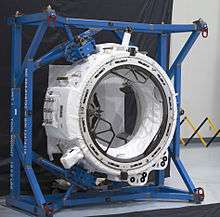International Docking Adapter


The International Docking Adapter (IDA) is a spacecraft docking system adapter being developed to convert APAS-95 to the NASA Docking System (NDS)/ International Docking System Standard (IDSS). An IDA will be placed on each of the International Space Station's (ISS) two open Pressurized Mating Adapters (PMA), both of which will be connected to Node-2 (Harmony module).
History
Prior to IDA there were several different iterations of docking adapters that were meant to fill a similar role but were ultimately canceled.
APAS to LIDS Adaptor System
The APAS to LIDS Adaptor System (ATLAS) was announced in 2008.[1] It would have been placed on the open PMAs and converted APAS-95 to the Low Impact Docking System (LIDS).[1] ATLAS was planned to be launched on Orion's first two missions to the International Space Station.[1] Orion's missions to the ISS were later canceled altogether and its role as a crew transporter was replaced by the Commercial Crew Program.[2]
Common Docking Adapter

The Common Docking Adapter (CDA) was announced in 2009.[3] It was planned to be used to convert the Common Berthing Mechanism to the NASA Docking System.[4] The CDAs would have been attached directly to Node-2 forward and Node-2 zenith.[4] They would have been delivered on the Japanese HTV cargo spacecraft.[4]
Design
IDA converts APAS-95 to the NASA Docking System (which complies with the International Docking System Standard) and allows the transfer of crew, cargo, power and data.[5] IDA has a mass of 526 kg (1,160 lb), a height of 110 cm (42 in) and a width of 160 cm (63 in).[5][6] When including the docking targets, laser retro-reflectors and related systems that are arrayed around the outer perimeters, the outer diameter is about 240 cm (94 in).[5]
Boeing is the primary contractor for the IDAs and the adapters were assembled at their Houston Product Support Center.[7][8] Parts from subcontractors came from 25 American states and the primary structure is from Russian company RSC Energia.[5][8]
Deployment of IDA modules
When each IDA arrives, Dextre will remove it from Dragon's trunk and move it to about 30 cm (1 ft) from the front of the PMA. It will then move the IDA carefully into position until it is seated on the PMA and hold it there.[8] Astronauts during an Extravehicular activity would then complete the electrical connections and permanently connect it to the PMA.[8]
IDA-1 was planned to be attached to Node-2's forward PMA.[9] IDA-2 was originally planned to be attached to Node-2's zenith PMA.[9][10] But following the loss of IDA-1, IDA-2 was instead attached to Node-2's forward PMA (PMA-2).[11][12] IDA-3, a replacement for IDA-1, is planned to be installed at Node-2's zenith PMA (PMA-3).[11]
Launch and loss of IDA-1

In Feb 2015, it was reported that IDA-1 had been transported to the Kennedy Space Center and that IDA-2 was still at Boeing's Houston facility.[8] The systems and targets for IDA-1 were put through about a month of tests at the Space Station Processing Facility before being loaded for launch.[5]
IDA-1 was lost during the launch failure of SpX CRS-7 on June 28, 2015.[9][10][13]
Launch of IDA-2

IDA-2 was launched on SpX CRS-9 on 18 July 2016.[14] It was attached and connected to PMA-2 during a spacewalk on 19 August 2016.[12]
IDA-3 planning
IDA-3 is planned to be launched on the Dragon CRS-14 mission in early 2018.[11][15] IDA-3 is being built mostly from spare parts to speed construction.[15]
Gallery
 Rendering of IDA connected to a PMA
Rendering of IDA connected to a PMA Pre-IDA-1 loss, planned locations of the IDAs
Pre-IDA-1 loss, planned locations of the IDAs Post-IDA-1 loss, planned locations of the IDAs
Post-IDA-1 loss, planned locations of the IDAs
See also
References
| Wikimedia Commons has media related to International Docking Adapter. |
- 1 2 3 Coppinger, Rob (4 Jan 2008). "NASA develops new docking system for Constellation". London: Flightglobal. Retrieved 19 January 2015.
- ↑ Klotz, Irene (18 June 2014). "Orion No Backup for Commercial Crew, Says Bolden". SpaceNews. Retrieved 28 February 2015.
- ↑ "Recovery Act: United States On-orbit Segment Phase II Development of International Space Station Common Docking Adapter". SpaceRef. 7 Oct 2009. Retrieved 28 February 2015.
- 1 2 3 Hatfield, Skip (17 Nov 2010). "NASA Docking System (NDS) Technical Integration Meeting" (PDF). NASA. Retrieved 28 February 2015.
- 1 2 3 4 5 Siceloff, Steven (27 June 2015). "Docking Adapter Sets Stage for Commercial Crew Craft". Kennedy Space Center, Florida, USA: NASA. Retrieved 28 June 2015.
- ↑ "SpaceX CRS-7 Mission Overview" (PDF). NASA. June 2015. Retrieved 28 June 2015.
- ↑ "SpaceX Pre-Launch Briefing from NASA's Kennedy Space Center". NASA. 27 June 2015. Retrieved 28 June 2015.
- 1 2 3 4 5 "Space Station Live: The ABCs of IDA (video)". NASA. 20 Feb 2015. Retrieved 28 February 2015.
- 1 2 3 Hartman, Dan (23 July 2012). "International Space Station Program Status" (PDF). NASA. Retrieved 10 August 2012.
- 1 2 Hartman, Daniel (July 2014). "Status of the ISS USOS" (PDF). NASA Advisory Council HEOMD Committee. Retrieved 26 October 2014.
- 1 2 3 Scimemi, Sam (November 4, 2015). "HSF Transition from ISS to cis-lunar space and ISS Status" (PDF). NASA. Retrieved 29 November 2015.
- 1 2 Harwood, William (19 August 2016). "Spacewalkers attach docking adapter to space station for commercial vehicles". Spaceflight. Retrieved 20 August 2016.
- ↑ Foust, Jeff (28 June 2015). "Docking Adapter, Satellites, Student Experiments Lost In Dragon Failure". SpaceNews. Retrieved 29 June 2015.
- ↑ Jason Rhian (18 July 2016). "SpaceX Conducts Second Ground Landing After Launch Of CRS-9 Dragon To ISS". Spaceflight Insider.
- 1 2 Stephen Clark (1 May 2016). "Boeing borrows from inventory to speed docking adapter delivery". Spaceflight Now.

